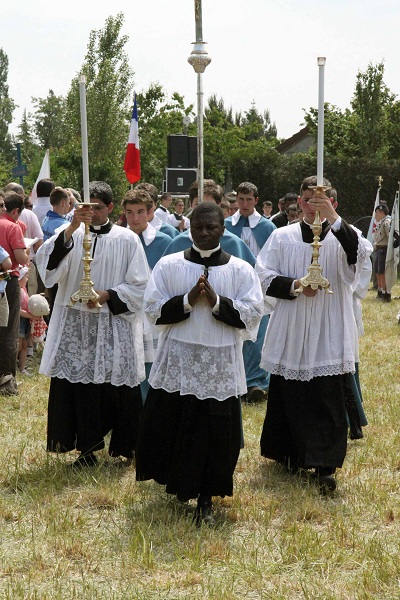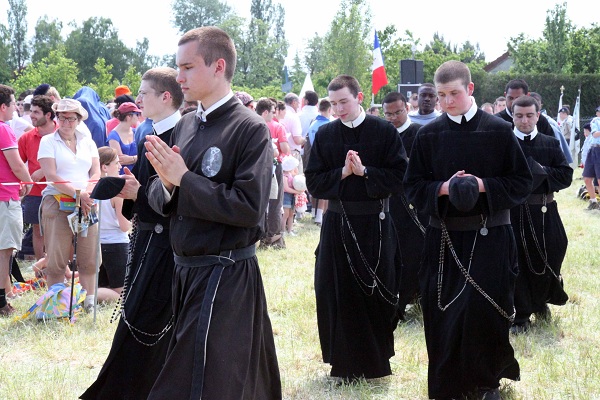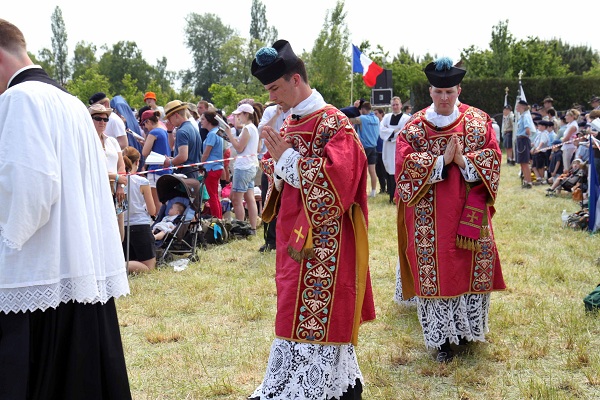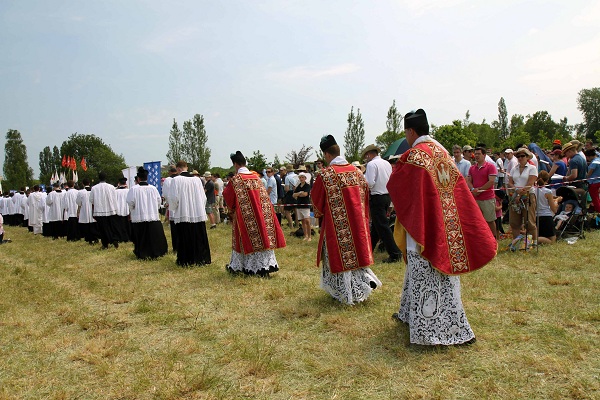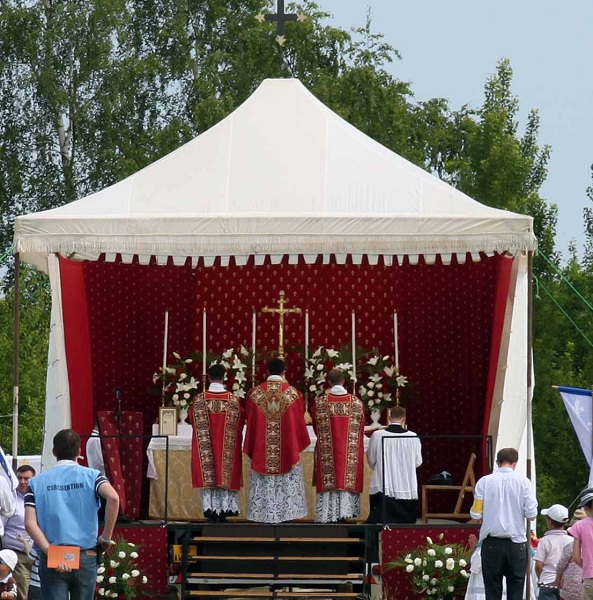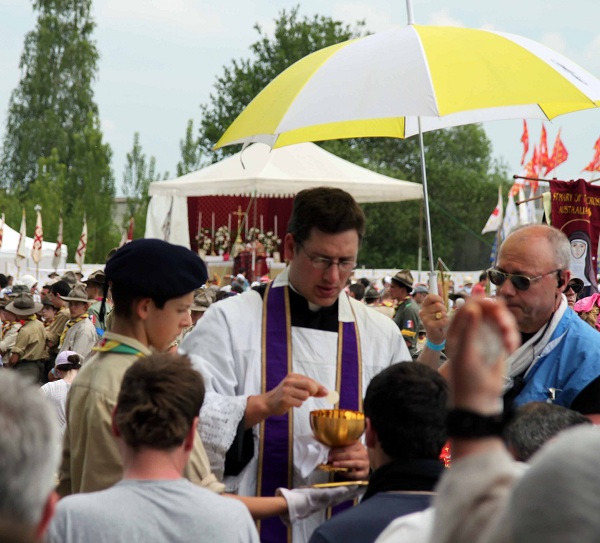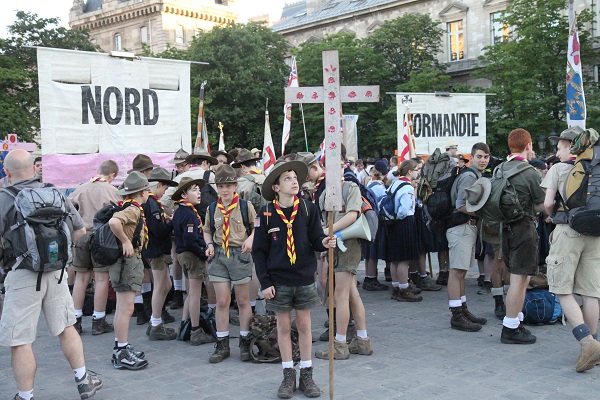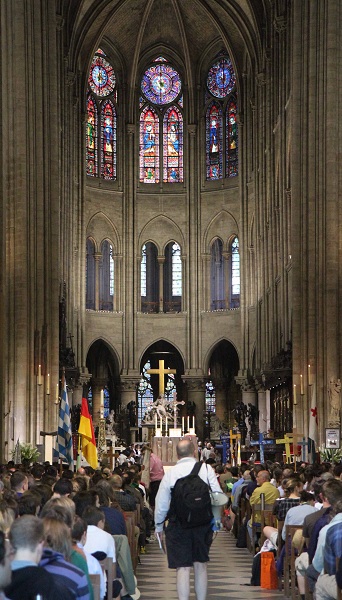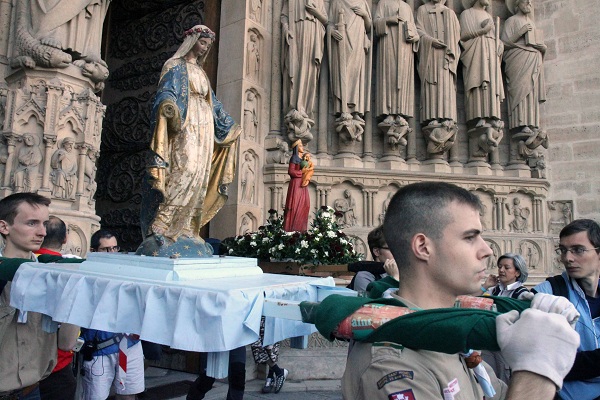
Early Monday.
The Third Day of the Pilgrimage – Pentecost Monday.

The chapter of Blessed Karl of Hapsburg -Lorraine (nice of the French – he was on the other side in the Great War).

The pilgrims assemble. On the third day many families have joined the march. It is claimed that the overall number of pilgims swelled to 10,000-15,000 on this day.


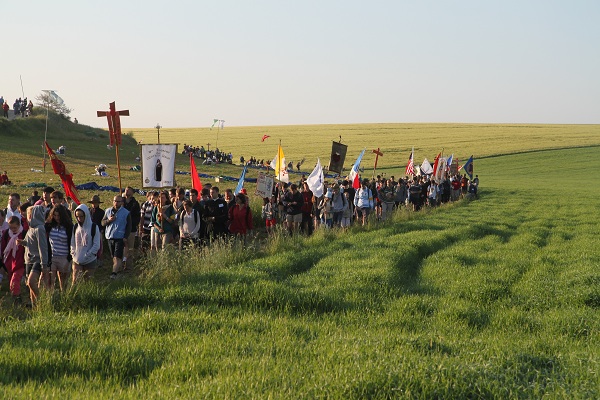

The pigrimage route crosses fields filled with flowers.

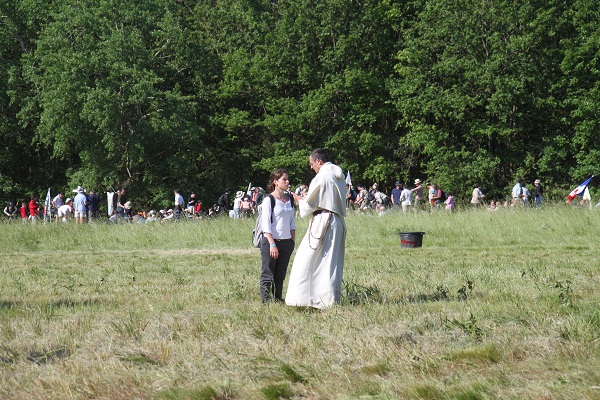
Confession in the fields during a pause in the pilgrimage.
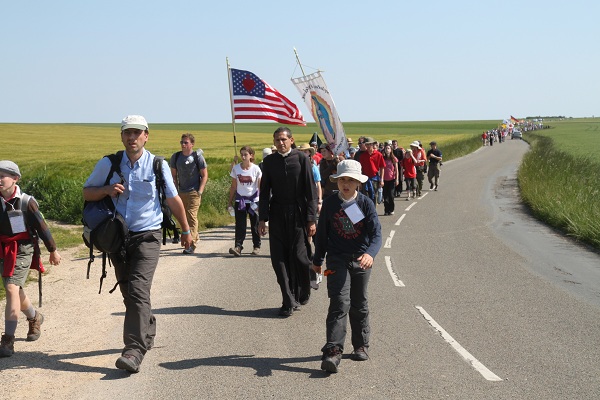


The pilgrims are often greeted by appreciative spectators on the last day.

Because of the open and gently rolling terrain crossed on Monday a pilgrim can finally get an idea of the sheer number of participants.

It is the third day of marching in the heat and the last leg of the pilgrimage begins to take a toll.

Chartres!
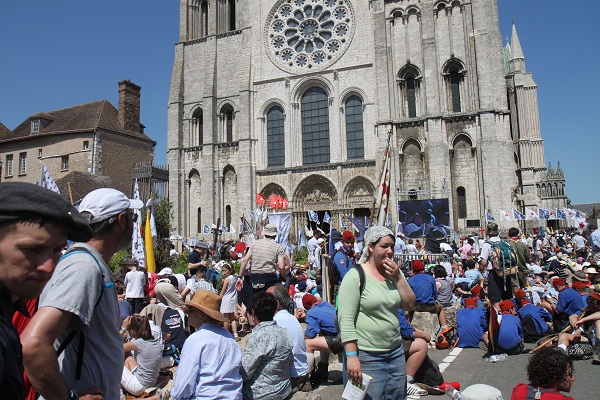
Misfortune for the Americans – just as in 2010 they must sit outside in the blazing sun. ( There is a rotation of chapters who enter the cathedral each year since the cathedral cannot accomodate all the pilgrims.)
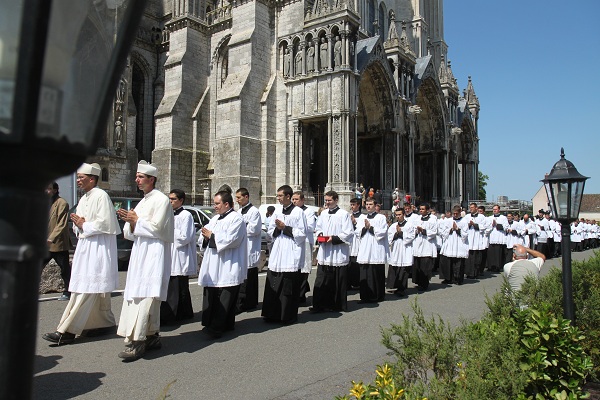
The procession to the Mass.

Dominicans
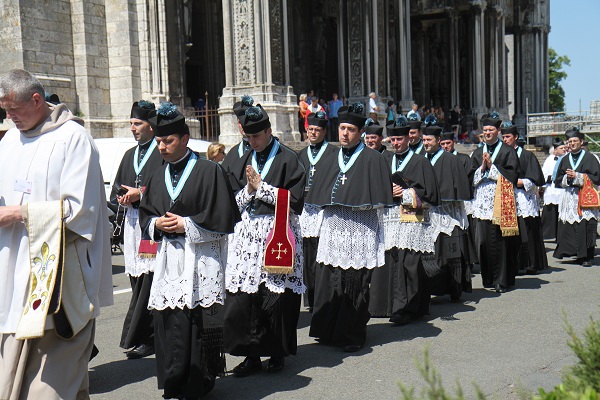
The Institute of Christ the King


His Excellency.

"You can understand my astonishment when I found that the final edition of the new Roman Missal in many ways did not correspond to the Conciliar texts that I knew so well, and that it contained much that broadened, changed or even was directly contrary to the Council's provisions."
*****
Alfons Maria Cardinal Stickler,S.D.B. (1910-2007) was not a fan of the Novus Ordo. He was in a position to know. He served as a peritus on three Conciliar commissions: the Commission for the Clergy, the Commission for Seminaries and Universities, and the Commission on the Liturgy. Here are some of his thoughts on what the Liturgy is supposed to be for Catholics, but has not been because of the deformations of the post-Conciliar Church.
"When we consider that the Orthodox churches, despite their separation from the rock of the Church, through the symbolic expression and theological progress that continuously found entrance into their liturgy, have preserved the correct beliefs and the sacraments, every Roman Catholic liturgical reform should rather increase the symbolic richness of its form of worship than (sometimes even drastically) decrease it."
*****
"The Church and the liturgy grow and develop together, but always in such a way that the earthly is organized around the heavenly. The Mass comes from Christ; it was adopted by the apostles and their successors as well as by the Fathers of the Church; it developed organically, with the conscious retention of its substance. The liturgy developed along with the Faith that is contained within it; thus we can say, with Pope Celestine I, in his writings to the Gallican bishops in the year 422: Legem credendi lex statuit supplicandi: The liturgy contains, and in proper and comprehensible ways, brings the Faith to expression. In this sense the constancy of the liturgy participates in the constancy of the Faith itself; indeed it contributes to its protection. Never has there been, therefore, in any of the Christian-Catholic rites, a break, a radically new creation-with the exception of the post-Conciliar reform. But the Council again and again demanded for the reform a strict adherence to tradition. All reforms, beginning with Gregory I through the Middle Ages, during the entry into the Church of the most disparate peoples with their various customs, have observed this ground rule. This is, incidentally, a characteristic of all religions, including non-revealed ones, which proves that an attachment to tradition is standard in any religious worship, and is therefore natural."
*****
"It is not surprising, therefore, that every heretical offshoot from the Catholic Church featured a liturgical revolution, as is most clearly recognized in the case of the Protestants and the Anglicans; while the reforms effected by the popes, and particularly stimulated by the Council of Trent and carried out by Pope Pius V, through those of Pius X, Pius XII and John XXIII, were no revolutions, but merely insignificant corrections, alignments and enrichments."
*****
"There are several clear examples of what the post-Conciliar reform actually produced, above all in its core, the radically new Ordo Missae. The new introduction to the Mass grants a significant place to many variants and, through further concessions to the imagination of the celebrants with their communities, is leading to a practically unlimited multiplicity."
*****
"The essential center, the sacrificial action itself, suffered a perceptible shift toward Communion, in that the entire Sacrifice of the Mass was changed into a Eucharistic meal, whereby in the consciousness of believers the integrating component of Communion replaced the essential component of the transforming act of sacrifice. Cardinal Ratzinger has expressly determined also, with reference to the most modern dogmatic and exegetical investigations, that it is theologically false to compare the meal with the Eucharist-which practically always occurs in the new liturgy. With that, the groundwork is laid for another essential change: in place of the sacrifice offered by an anointed priest as alter Christus comes the communal meal of the convened faithful under the presiding priest. The intervention of Cardinals Ottaviani and Bacci persuaded the Pope to overturn the definition [in the original General Instruction that accompanied the new Missal-Translator's note] that confirmed this change in the Sacrifice of the Mass; it was 'pulped down' by order of Paul VI. The correction of the definition resulted, however, in no change to the Ordo Missae itself."
*****
'The Eucharist is not only the unique mystery of our faith; it is also an everlasting one, of which we should always remain conscious. Our everyday Eucharistic life requires a medium that fully embraces this mystery-above all in the modern age, in which the autonomy and self-glorification of modern man resist every concept that goes beyond human knowledge, that reminds him of his limitations. Every theological concept becomes a problem for him, and the liturgy especially as a support of the Faith turns into a permanent object of demystification, that is, of humanizing to the point of making it absolutely understandable. For this reason, the banishing of mysterium fidei from the Eucharistic formula becomes a powerful symbol of demythologization, a symbol of the humanizing of the center of divine worship, of holy Mass."
*****
"In my research for the Council decree about the Latin language, I became aware of the concurring opinion of the entire tradition: up to Pope John XXIII, a clearly unfriendly attitude had been taken toward all preceding efforts to the contrary. Consider in particular the cases of the statement of the Council of Trent, sanctioned by anathema, against Luther and Protestantism; of Pius VI against Bishop Ricci and the Synod of Pistoia; and of Pius XI, who deemed the Church's language of worship as 'non vulgaris.' Yet this tradition is not at all a question only of ritual, although that is the aspect always emphasized; rather, it is important because the Latin language acts as a reverent curtain against profanation (instead of the iconostasis of the Easterners, behind which the anaphora takes place; NOTE: the FSSP Fathers have also reminded us of this use of Latin as a verbal "iconostasis") and because of the danger that through the vulgar language the whole action of the liturgy might be profaned, which in fact often happens today."
*****
There's much more here. If you value the traditional Latin Mass and scholarship on it, read anything Cardinal Stickler has written.
fonte:http://gregorianrite2007.blogspot.com/*****
Alfons Maria Cardinal Stickler,S.D.B. (1910-2007) was not a fan of the Novus Ordo. He was in a position to know. He served as a peritus on three Conciliar commissions: the Commission for the Clergy, the Commission for Seminaries and Universities, and the Commission on the Liturgy. Here are some of his thoughts on what the Liturgy is supposed to be for Catholics, but has not been because of the deformations of the post-Conciliar Church.
"When we consider that the Orthodox churches, despite their separation from the rock of the Church, through the symbolic expression and theological progress that continuously found entrance into their liturgy, have preserved the correct beliefs and the sacraments, every Roman Catholic liturgical reform should rather increase the symbolic richness of its form of worship than (sometimes even drastically) decrease it."
*****
"The Church and the liturgy grow and develop together, but always in such a way that the earthly is organized around the heavenly. The Mass comes from Christ; it was adopted by the apostles and their successors as well as by the Fathers of the Church; it developed organically, with the conscious retention of its substance. The liturgy developed along with the Faith that is contained within it; thus we can say, with Pope Celestine I, in his writings to the Gallican bishops in the year 422: Legem credendi lex statuit supplicandi: The liturgy contains, and in proper and comprehensible ways, brings the Faith to expression. In this sense the constancy of the liturgy participates in the constancy of the Faith itself; indeed it contributes to its protection. Never has there been, therefore, in any of the Christian-Catholic rites, a break, a radically new creation-with the exception of the post-Conciliar reform. But the Council again and again demanded for the reform a strict adherence to tradition. All reforms, beginning with Gregory I through the Middle Ages, during the entry into the Church of the most disparate peoples with their various customs, have observed this ground rule. This is, incidentally, a characteristic of all religions, including non-revealed ones, which proves that an attachment to tradition is standard in any religious worship, and is therefore natural."
*****
"It is not surprising, therefore, that every heretical offshoot from the Catholic Church featured a liturgical revolution, as is most clearly recognized in the case of the Protestants and the Anglicans; while the reforms effected by the popes, and particularly stimulated by the Council of Trent and carried out by Pope Pius V, through those of Pius X, Pius XII and John XXIII, were no revolutions, but merely insignificant corrections, alignments and enrichments."
*****
"There are several clear examples of what the post-Conciliar reform actually produced, above all in its core, the radically new Ordo Missae. The new introduction to the Mass grants a significant place to many variants and, through further concessions to the imagination of the celebrants with their communities, is leading to a practically unlimited multiplicity."
*****
"The essential center, the sacrificial action itself, suffered a perceptible shift toward Communion, in that the entire Sacrifice of the Mass was changed into a Eucharistic meal, whereby in the consciousness of believers the integrating component of Communion replaced the essential component of the transforming act of sacrifice. Cardinal Ratzinger has expressly determined also, with reference to the most modern dogmatic and exegetical investigations, that it is theologically false to compare the meal with the Eucharist-which practically always occurs in the new liturgy. With that, the groundwork is laid for another essential change: in place of the sacrifice offered by an anointed priest as alter Christus comes the communal meal of the convened faithful under the presiding priest. The intervention of Cardinals Ottaviani and Bacci persuaded the Pope to overturn the definition [in the original General Instruction that accompanied the new Missal-Translator's note] that confirmed this change in the Sacrifice of the Mass; it was 'pulped down' by order of Paul VI. The correction of the definition resulted, however, in no change to the Ordo Missae itself."
*****
'The Eucharist is not only the unique mystery of our faith; it is also an everlasting one, of which we should always remain conscious. Our everyday Eucharistic life requires a medium that fully embraces this mystery-above all in the modern age, in which the autonomy and self-glorification of modern man resist every concept that goes beyond human knowledge, that reminds him of his limitations. Every theological concept becomes a problem for him, and the liturgy especially as a support of the Faith turns into a permanent object of demystification, that is, of humanizing to the point of making it absolutely understandable. For this reason, the banishing of mysterium fidei from the Eucharistic formula becomes a powerful symbol of demythologization, a symbol of the humanizing of the center of divine worship, of holy Mass."
*****
"In my research for the Council decree about the Latin language, I became aware of the concurring opinion of the entire tradition: up to Pope John XXIII, a clearly unfriendly attitude had been taken toward all preceding efforts to the contrary. Consider in particular the cases of the statement of the Council of Trent, sanctioned by anathema, against Luther and Protestantism; of Pius VI against Bishop Ricci and the Synod of Pistoia; and of Pius XI, who deemed the Church's language of worship as 'non vulgaris.' Yet this tradition is not at all a question only of ritual, although that is the aspect always emphasized; rather, it is important because the Latin language acts as a reverent curtain against profanation (instead of the iconostasis of the Easterners, behind which the anaphora takes place; NOTE: the FSSP Fathers have also reminded us of this use of Latin as a verbal "iconostasis") and because of the danger that through the vulgar language the whole action of the liturgy might be profaned, which in fact often happens today."
*****
There's much more here. If you value the traditional Latin Mass and scholarship on it, read anything Cardinal Stickler has written.
Cardinal Alfons Stickler:Legitimacy from Tradition Now we have another legitimacy which is coming from the internal sensibility for this rite. You know that worship and worshipping in every region is attached closely to tradition. No worship is easily changed in any religion. All are attached closely to tradition. This is true in a special manner also for our Rite, our Roman Latin Rite. Its changing after the Council was said to be a question of natural development; but, for every Rite, thinking should be only organical, adopted slowly in order to give no impression of changing, of cutting tradition. Unfortunately many people had this impression after the so- called "reform" established by the Commission, which was instituted by Pope Paul VI after the Council. Many things were changed which really cut the hearts of many of the Faithful - I would say sometimes the best of the Faithful.

Address by H.E. Cardinal Alfons Stickler
on June 20, 1992 at the Annual General Meeting
of the Latin Mass Society
The first idea I will communicate with you is that you can be sure that your movement has full legitimacy in the Church. Some have said that we are not legitimate. This is not true because, if you remember article 4 of the Liturgical Constitution, the Council Fathers explicitly said all the venerable rites have to be preserved. Some people say this is valid for all the other rites, with the exception of the Roman Latin rite. This is not so. Because article 4 says: all the rites legitimately recognised. This was not only established for the rites existing at that time, during the Council, but also for the rites that should be approved afterwards. Now the Old Latin rite was really recognised after the changing of the former Latin Roman rite because, as you know, exception was given immediately for old priests and, in England, you had fortunately your great Cardinal Heenan, who obtained the Indult for England and Wales in 1971. Then, we had the Motu Proprio, the Indult of the Pope, and later on Ecclesia Dei which was clearly confirmed by the Pope; for example, when he spoke to the Abbot of Le Barroux in 1990, who had asked explicitly for this rite. Consequently, a new authority was given to the old Rite on the base of the liturgical Constitution of the Council itself. This recognition is coming from the Holy See, from the Pope, under the conditions given at the moment of the new approbation, which institutes a real legitimation of the Old Rite (and is available now). So, if you fulfil the conditions for the continuation of the Old Rite, it is legitimate for you. This is the external legitimacy of your movement.
Legitimacy from Tradition
Now we have another legitimacy which is coming from the internal sensibility for this rite. You know that worship and worshipping in every region is attached closely to tradition. No worship is easily changed in any religion. All are attached closely to tradition. This is true in a special manner also for our Rite, our Roman Latin Rite. Its changing after the Council was said to be a question of natural development; but, for every Rite, thinking should be only organical, adopted slowly in order to give no impression of changing, of cutting tradition. Unfortunately many people had this impression after the so- called "reform" established by the Commission, which was instituted by Pope Paul VI after the Council. Many things were changed which really cut the hearts of many of the Faithful - I would say sometimes the best of the Faithful. This is also a reason to continue the tradition in the external forms of the Rite we professed before. This is the proof of the old saying "Lex orandi - Lex credendi". Unfortunately too many things have confused the common faithful in our Church. This is one of the reasons why they no longer have the security of an unchanging rite. "Lex orandi - Lex credendi." If the Law of worshipping is changed so profoundly, our faith has lost the help we had in our worship.
No Polemics
Now the next idea I want to express is that we have to avoid, always in our life and in our discussions, in our general behaviour in our association, every kind of polemics, because there is always a danger of hurting others. If there are polemics, they will say "Ah, you are a sect with no more reasoning". So we have to profess our attachment to the Old Rite calmly, reasoning with them but without polemics.
We have to explain also to ourselves the reasons for following the Old Latin Rite and we have many reasons for it. The first I have mentioned already; it is the absolute tradition of Liturgy in every religion to have no change with the past because we have to preserve that rite as the expression of our Faith. You know that the Oriental Church saved the common truth, that is the Catholic Truth, by preserving the rite. They preserved all the Sacraments because they were attached so strongly to the rite which they would never changed. The other heretics - Protestants and so on - have changed the Faith because they have changed the Rite.
The Catholic Church a Communio
The Vatican Council says explicitly that we have "a communio" in the Catholic Church, the Pope with the Bishops and with the priests in all parts of the world. We are particular churches but we are all in one Catholic Church. If we have the same faith, even with the different rites, but not in all our fundamental teaching, then we have not the complete Communion. For example, the Oriental Church is a Church not in complete communion because there is not preserved the dogma and truth in the Primacy of the Pope. They have not the whole truth, but most of it they have preserved. All the other churches are not called "churches" in the full sense but religious communities. This means that they have not the complete substance of our Faith. So the Catholic Church in the case of the Rites, who did not absolutely preserve the truths of the Catholic and Latin Rites has not with them this unity. This is very important in order to confirm our sensibilities for the Old Rite which is really that of the "Lex Credendi" expressed by the "Lex Orandi".
The Modernity of the Church
We have to consider still another idea. Modern Catholics say "Now we have to cut away all the old things. We must be modern." But this modernity is not the modernity of the Church because we have to preserve the whole substance which is our heritage from past generations. So if many of the Bishops ask us "Why do you follow the Old Rite?" We can answer very easily: "The new rite was introduced after the Council as a matter of pastoral care. This means that the Faithful should be animated more and more by the new form of rites to be better in Catholic truth and life. But many good people in the world who still believe in the truths of the Catholic Church are not satisfied about the innovations introduced into the Mass. Can you say then that the pastoral purpose has been fulfilled?" I think, through my experience, that there is more and more dissatisfaction becoming stronger always in all the categories of age, social positions, even in many young people.
Further we are told that the truth about the Mass, about the centre of the liturgy has not really changed. But we can ask; have we the same sense, the same reverence we had before - and perhaps still have - when we assist at the Old Roman Rite? Or have we a loss of reverence, of awe of our biggest mystery, our faith in the Holy Mass? In the sacrifice? It was admitted officially when, two years ago, on the Silver Jubilee of the changing of the Rite, authorities in Rome admitted that there was a great loss of awe in the Mass - the most important rite of our worship.
This is the experience of all who travel around everywhere. We have lost what really is at the heart of our worshipping in the Holy Sacrifice. Many times we get the impression that it is man being worshipped but not God. We have a Communion meal, but not a Sacrifice. I think that this has proved one of the most important changes in the general attitude to the Holy Sacrifice of the Mass. When I studied Theology I was told that the centre of the Mass is the Consecration, the Communion is quite necessary for the priest but supposes the sacrificial act already done. Today, at the centre is the meal. What we have to do when confronted with the situation as members of the Association, you represent here. Firstly we have to tell our Bishops and our parish priests that we are not satisfied with the new rite; that we have good reasons for being attached to the Old Mass. We should explain all the reasons why it should be available for those who ask for it. We must also explain that the Holy Father has granted the privilege contained in the Motu Proprio; Ecclesia Dei and that he wanted to take care of the sensibilities of those attached to the Old Latin Mass.
Loyalty Always to the Holy See
Our fidelity to the Old Rite must always conform to the decisions of the Holy See, with all the conditions satisfied which the Holy See has laid down for this purpose. We should persist in our fidelity to this heritage, which is a heritage of truth and because we can be sure that also today, the old Latin Mass is completely valid and "Lex Orandi" reflects the "Lex Credendi". If we are faithful in "Oratione", we can be certain to remain also attached to the truth in "Credendo", in full devotion to our heritage of Faith.
fonte:http://www.latin-mass-society.org/sticklms.htm

 inundado por um mistério de luz que é Deus e N´Ele vi e ouvi -A ponta da lança como chama que se desprende, toca o eixo da terra, – Ela estremece: montanhas, cidades, vilas e aldeias com os seus moradores são sepultados. - O mar, os rios e as nuvens saem dos seus limites, transbordam, inundam e arrastam consigo num redemoinho, moradias e gente em número que não se pode contar , é a purificação do mundo pelo pecado em que se mergulha. - O ódio, a ambição provocam a guerra destruidora! - Depois senti no palpitar acelerado do coração e no meu espírito o eco duma voz suave que dizia: – No tempo, uma só Fé, um só Batismo, uma só Igreja, Santa, Católica, Apostólica: - Na eternidade, o Céu!
inundado por um mistério de luz que é Deus e N´Ele vi e ouvi -A ponta da lança como chama que se desprende, toca o eixo da terra, – Ela estremece: montanhas, cidades, vilas e aldeias com os seus moradores são sepultados. - O mar, os rios e as nuvens saem dos seus limites, transbordam, inundam e arrastam consigo num redemoinho, moradias e gente em número que não se pode contar , é a purificação do mundo pelo pecado em que se mergulha. - O ódio, a ambição provocam a guerra destruidora! - Depois senti no palpitar acelerado do coração e no meu espírito o eco duma voz suave que dizia: – No tempo, uma só Fé, um só Batismo, uma só Igreja, Santa, Católica, Apostólica: - Na eternidade, o Céu! 



